Lowville, April 7
We had an awesome first day of banding at Lowville with a total of 27 birds caught (18 banded and 9 recaptured). For an early season day we had a decent number of birds and good diversity. The highlight was a Sharp-shinned Hawk! Although we get a fair number of them moving through during migration, it is rare that we catch these small forest hawks. But it does happen on occasion, and wow what a fantastic surprise it was to find him in the net! What a great way to kick off the season!
~Ashley Jensen
April 7
Banded:
3 American Goldfinch
1 Golden-crowned Kinglet
1 American Tree Sparrow
2 Black-capped Chickadee
4 Slate-colored Junco
4 Song Sparrow
2 Fox Sparrow
1 Sharp-shinned Hawk
Recaptures:
5 Black-capped Chickadee
1 Eastern Phoebe
1 White-breasted Nuthatch
1 Blue Jay
1 American Robin
TOTAL: 27 (18 banded & 9 recaps)
April 9
Banded:
5 American Goldfinch
2 Black-capped Chickadee
1 American Tree Sparrow
4 Song Sparrow
1 Hermit Thrush
2 White-throated Sparrow
Recaps:
9 Black-capped Chickadee
2 Song Sparrow
2 White-throated Sparrow
TOTAL: 28 (15 banded, 13 recaps)
April 10 and 11, 2022 : A Diversity of Birds and Birders
On Sunday, April 10th I set out to band with David Brewer, Liam Thorne and Sam Lewis. David is a Master Bander, who has made countless and notable contributions to the conservation of birds and probably needs no introduction. Liam is in Grade 8 and Sam is in Grade 9 and represent two of our young and keen birders. I confidently predict that our young volunteers, including these two boys, will one day become movers and shakers in the field of bird and wildlife conservation.
The weather was less than ideal. Shortly after opening we had to close the nets due to heavy snow. Thankfully, the snow disappeared, and warming temperatures allowed us to safely reopen. What with the migration just getting underway and the mid-morning closure we didn’t expect large numbers of birds. Nevertheless, we did experience a lovely variety of species including:
1 Black-capped Chickadee,
1 Winter Wren,
1 Song Sparrow,
3 Golden-crowned Kinglets (all male),
1 Brown Creeper, and
1 American Goldfinch.
We also recaptured:
1 Black-capped Chickadee,
1 Northern Cardinal,
1 Hermit Thrush
That makes for a grand total of 11 birds, with 8 banded and 3 recaptured, representing a total of 6 different species.
Interestingly, the Hermit Thrush had a lot of fat on him. We suspect he was using the Lowville area as a staging ground to fuel up for further travel up north.
On Monday, April 11th, I returned to band with Ashley Jensen, Dave Maida, Patti Murphy and four more women I met through birding walks at the Royal Botanical Gardens. Ashley, our Bander-in-Charge, has 10 years of banding experience and completed a Masters in Ruffed Grouse population genetics. Dave had a career in forestry management and has been a banding volunteer since 2017. He is also an HBO Council Member. Patti has been practicing veterinary medicine for 32 years, and with retirement around the corner, she is interested in learning to become a scribe.
At 8 am, Pat Turner, Barb Dermott, Suzanne Batchelor, and Judi Dunn arrived. Pat is a former banker and risk management analyst for Bank of Montreal. Barb is a former retail manager and a marketing and communications specialist. Suzanne is a former chemical analyst for Environment Canada and Judi is a former warehouse manager for Hyundai. This was their first time at the Lowville Banding Station to experience songbird banding.
The day’s weather brought a welcomed contrast from the day before with warmer temperatures and blue skies. Again, the bird numbers were somewhat low, but with local and early migrant representation, we enjoyed much diversity.
We banded 18 birds:
7 Golden-crowned Kinglets,
3 American Goldfinches,
1 Slate-coloured Junco,
1 Song Sparrow,
2 White-throated Sparrows,
1 Fox Sparrow,
1 Cedar Waxwing, and
1 Northern Cardinal.
We also recaptured:
4 Black-capped Chickadees,
1 Downy Woodpecker,
1 White-breasted Nuthatch and
1 Carolina Wren.
We had 25 birds altogether representing 12 species. The recaptured birds could all very well be local to the area. The White-breasted Nuthatch was a healthy female aged as an “After Second Year” (ASY). This means the bird is at least 3 years old but could be more. When she was released, she flew up into a nearby tree to rejoin her mate who appeared to be waiting for her there. Interestingly, her mate was recaptured a few days back and he is also a healthy “After Second Year” bird. They could very well be a long-standing couple. Once reunited, they instantly began chattering. We could not help but imagine that they were sharing their banding stories and were especially happy to be reunited. The exchange lasted only a few seconds and then they were back to the important activities of the day, foraging and family planning. We all stood and watched this endearing reunion in awe.
The special lesson of the day was ageing and sexing a Cedar Waxwing. One of the key characteristics, among others used, was the 8 red appendages indicating that this bird was an after second year (ASY) bird, according to Pyle.
These two days provided a chance to pay close attention to some key local and early migrant birds, each with their own story and unique characteristics. Our banders and visitors, also each with a unique background and life experience, converged here, at the Lowville Banding Station, to share their fascination and deep passion for birds. The bird numbers were low, but the diversity of life was exceptional.
By Catherine Manschot, Volunteer, Lowville Banding Station

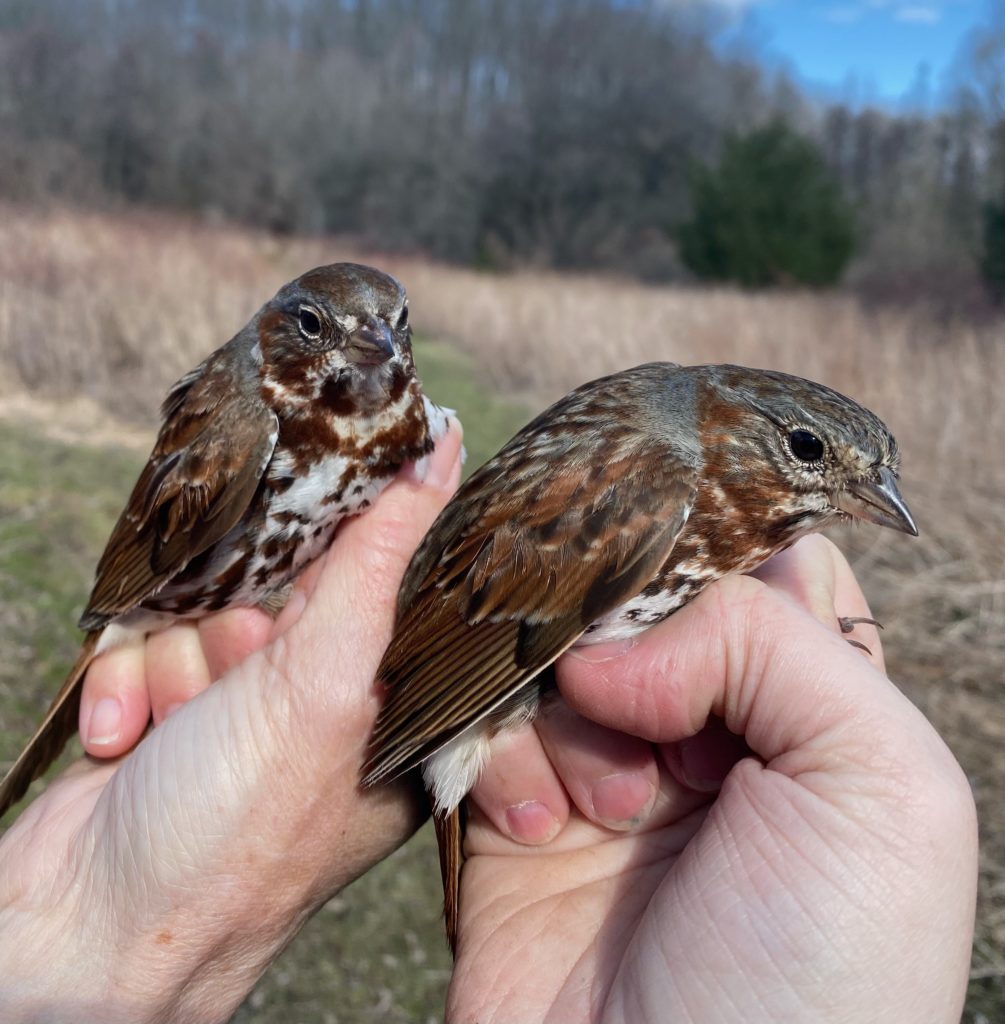
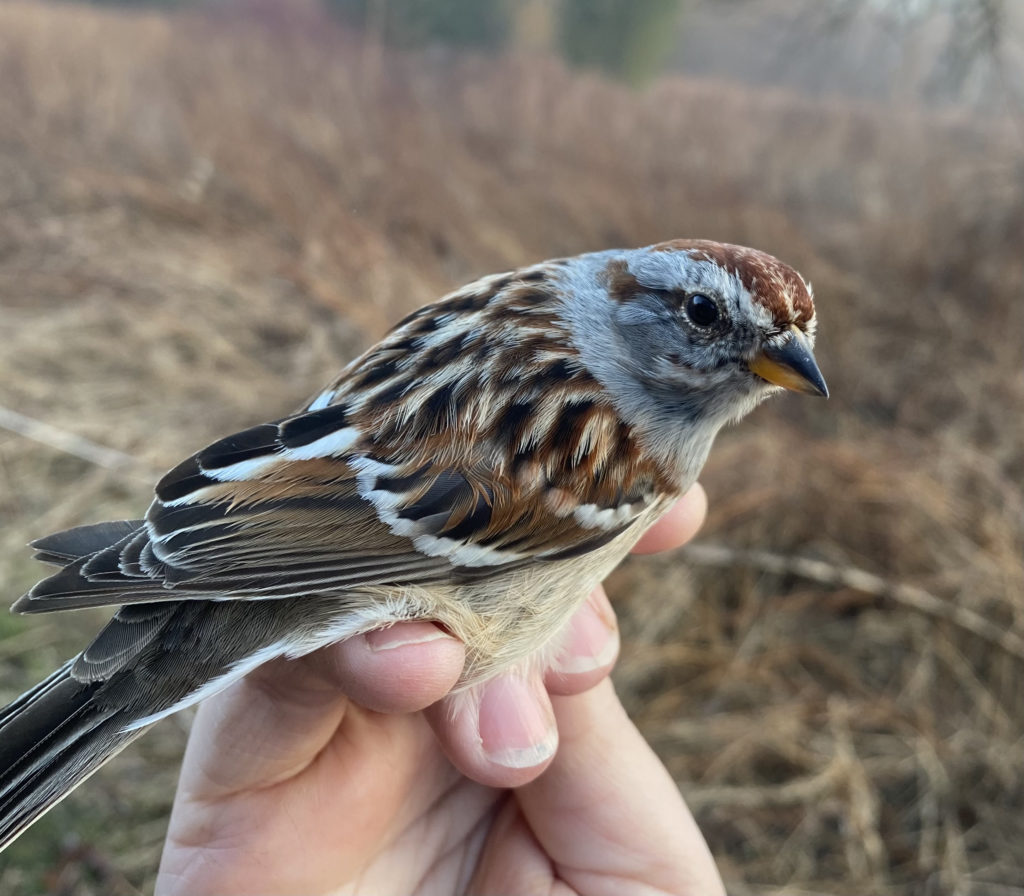
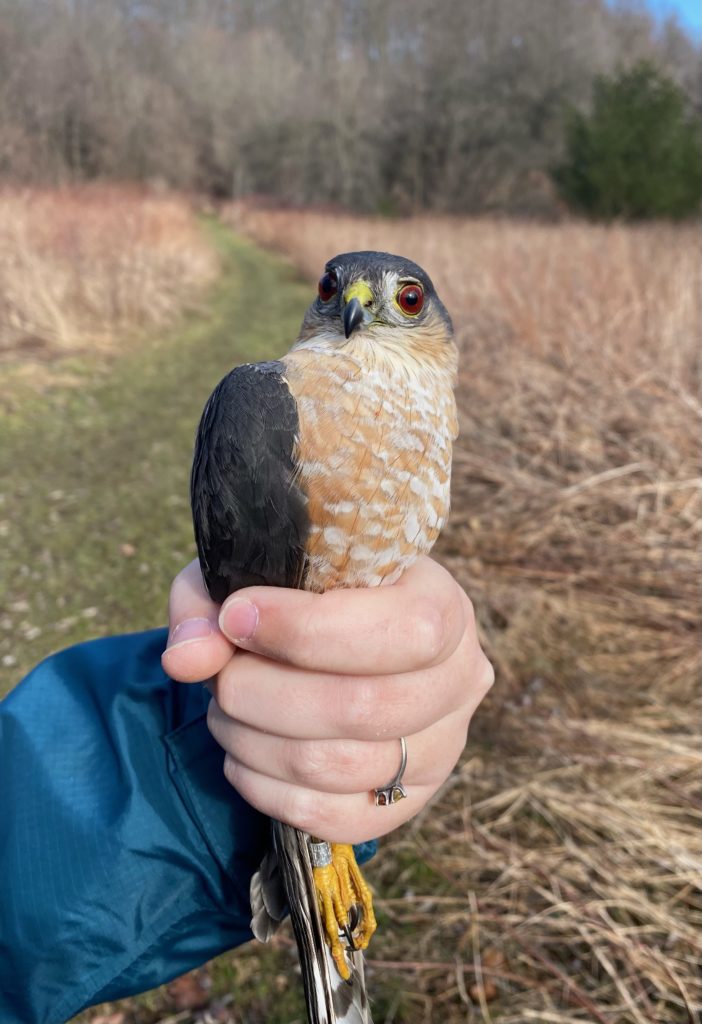
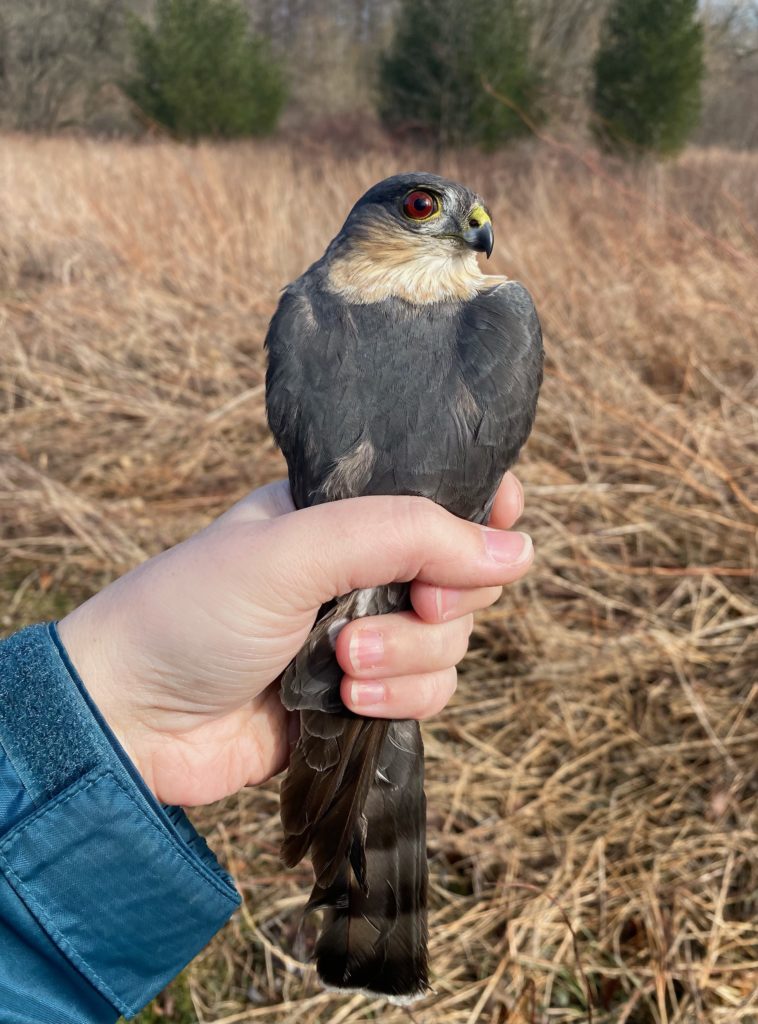
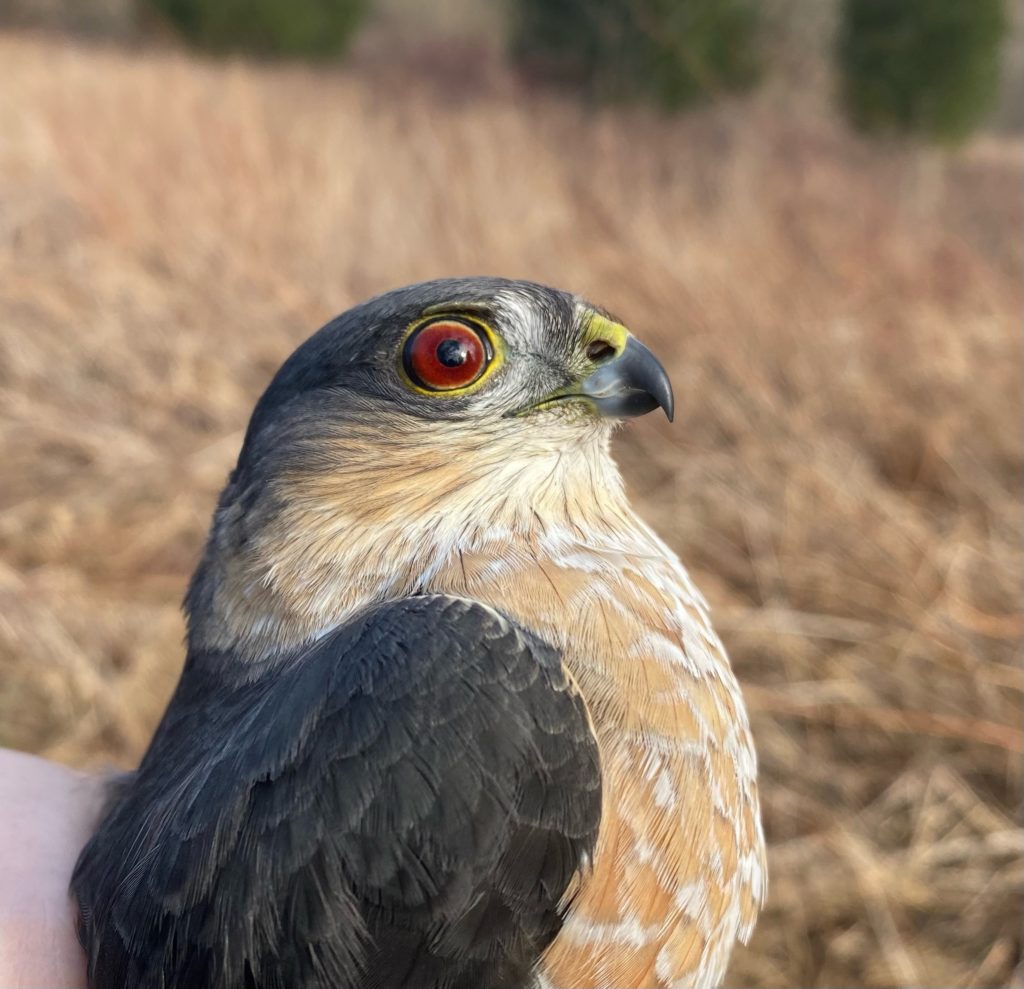
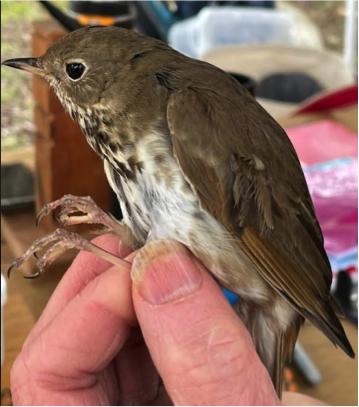
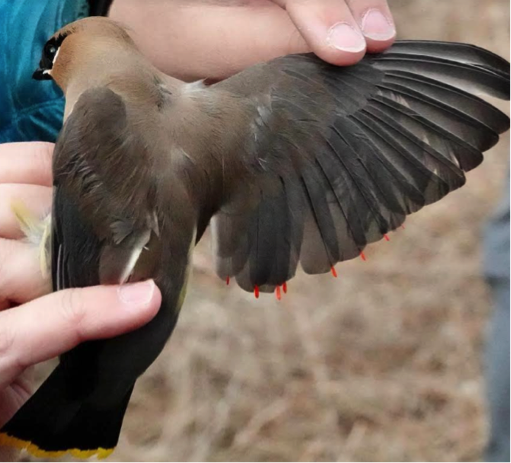
Nice write-ups folks!! Nice to see.
And you’ve been having some good banding days too!!